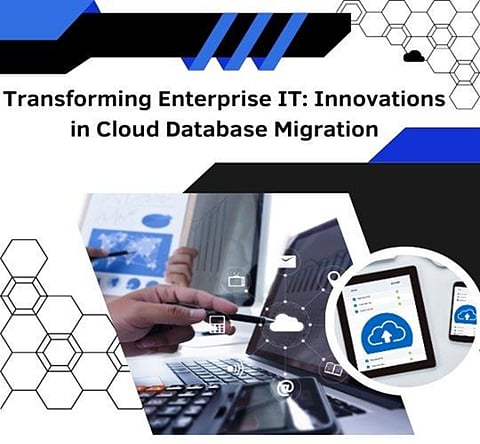

In today’s rapidly evolving digital landscape, organizations are reimagining their IT infrastructure to enhance efficiency and scalability. One of the most significant advancements in this transformation is the migration of databases to cloud platforms. Krishna Anumula, an expert in enterprise technology, explores the intricacies of database migration to cloud environments in his research, offering valuable insights into optimizing performance, security, and cost-efficiency.
Organizations' migration away from on-premises databases to cloud-based databases is occurring quickly, partly due to the scalability, cost-effectiveness and flexibility cloud solutions provide. Cloud platforms enable organizations to scale their resources dynamically based on demand, which allows them to avoid over-provisioning to ensure their application is performant. Additionally, cloud databases eliminate the expenses of hardware maintenance, upgrades, and infrastructure management, freeing organizations to focus on innovation.
Enhanced security, automated backups, and seamless integration with advanced analytics further add to the appeal of cloud-based systems. With global accessibility and real-time data synchronization, businesses can improve collaboration and decision-making. With global accessibility and real-time data synchronization, businesses can improve collaboration and decision-making. With the continuing acceleration of digital transformation, cloud databases now have a prominent place in enterprises' efforts to achieve agility, efficiency, and future-proof data management. Thus, they are a strategic advantage in a competitive marketplace.
To undertake a successful cloud migration, organizations need to start by assessing the pre-migration evaluation, existing database infrastructure and dependencies, and a thorough review of systems performance. The organizations which get involved in thorough workload assessment usually assuredly encounter and therefore generate processes to mitigate such issues. Weaving in relations and dependencies between the applications and data flows will facilitate a smoother transition with minimum disruption.
Cloud providers offer diverse hosting options for enterprise databases, each tailored to specific operational needs. Managed database services take care of critical administrative tasks like backups, patching, and monitoring, relieving the IT team from these duties and rendering the service more reliable. On the other hand, self-managed cloud services place configuration and sometimes security and optimization in the hands of the customers, thus making them suitable for businesses with complex or more customized database environments.
Appropriate considerations for deciding between these models are scalability, compliance, and resources. Those oriented toward efficiency shall prefer managed services, while those requiring finer control may resort to self-management. Choosing an appropriate hosting strategy then naturally follows cloud migration so that the hosting infrastructure meets the business needs while balancing automation, flexibility, and governance.
Security in cloud environments becomes a top priority during migration. The organization must move along with strong frameworks, including VPC design, IAM frameworks, and encryption policies. Network segmentation with stringent access controls holds sensitive data from exposure to cyber issues. Implementing MFA adds a layer of security while automated threat detection ensures timely monitoring and response.
Furthermore, staying resilient while applying continuous protection assessment, compliance checks, and risk management goes an extra mile. Enterprises mitigate vulnerability and cushion data protection with the secure cloud infrastructure, i.e., scalable and operationally efficient, toward the evolving threat landscape when these measurements are integrated.
Cloud databases must ensure business operations are disrupted as little as possible. Continuous data replication sends high-frequency updates that refer to on-premises transactions to ensure both databases remain synchronized. Migration tools for heterogeneous environments enable enterprises to migrate to cloud-based databases in a consistent, reliable, and effective manner, in cases where data integrity will not be compromised. Incremental, phased migration approaches let enterprises migrate incrementally, or in time, in a manner that allows the enterprise to remain operational for business continuity during the process.
After migrating a database to the cloud, continuous optimization is key to maximizing performance and cost efficiency. Cloud-native monitoring tools deliver real-time insights into database health, allowing proactive issue resolution. Automated resource scaling dynamically adjusts capacity, preventing over-provisioning and ensuring efficiency.
Regular updates and security patches enhance system integrity while maintaining compliance with evolving regulations. Performance tuning, indexing strategies, and query optimization further refine database operations. Additionally, leveraging serverless architectures and AI-driven analytics can enhance scalability and responsiveness. By implementing these strategies, organizations can fully capitalize on cloud benefits while maintaining security, reliability, and cost-effectiveness.
The evolution of cloud computing continues to introduce new innovations in database management. AI-driven automation is revolutionizing how enterprises optimize workloads, detect anomalies, and enhance security. The integration of multi-cloud strategies offers organizations greater flexibility, allowing them to distribute workloads across multiple cloud providers for increased resilience. As cloud technology advances, businesses that embrace these innovations will gain a competitive edge in the digital economy.
In conclusion, the migration of enterprise databases to cloud platforms represents a paradigm shift in IT strategy. By leveraging cloud infrastructure, organizations can achieve greater scalability, security, and efficiency. Krishna Anumula’s insights highlight the importance of meticulous planning, strategic decision-making, and continuous optimization in ensuring a successful cloud migration. As businesses continue to evolve, embracing cloud innovations will be key to maintaining a competitive edge in the ever-changing technological landscape.
